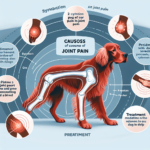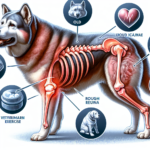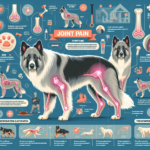Irish Setter Joint Pain: Causes, Symptoms, Prevention, and Treatment

Introduction
The Irish Setter, known for its striking red coat and exuberant personality, is a breed that has captured the hearts of dog lovers worldwide. Originating from Ireland, this breed was initially developed in the 18th century for hunting and retrieving game birds. With their keen sense of smell, agility, and boundless energy, Irish Setters quickly became popular among hunters. Today, they are cherished not only for their hunting prowess but also as loving family pets.
Despite their many admirable qualities, Irish Setters are prone to certain health issues, one of the most significant being joint pain. Joint health is crucial for this breed, given their active lifestyle and genetic predispositions. Understanding the causes, symptoms, prevention, and treatment of joint pain in Irish Setters can help owners ensure their pets lead a healthy and comfortable life.
Breed-Specific Joint Pain Risks
Genetic Predisposition
Irish Setters are genetically predisposed to several joint-related issues, including hip dysplasia, elbow dysplasia, and arthritis. Hip dysplasia is a condition where the hip joint does not fit into the hip socket properly, leading to pain and mobility issues. Elbow dysplasia involves abnormal development of the elbow joint, causing lameness and discomfort. Arthritis, a degenerative joint disease, can also affect Irish Setters, particularly as they age.
Age-Related Risks
As Irish Setters age, the risk of developing joint pain increases. Typically, signs of joint issues may start to appear when the dog reaches middle age, around 5 to 7 years old. However, some dogs may show symptoms earlier, especially if they have a genetic predisposition. Regular veterinary check-ups are essential to monitor joint health as the dog ages.
Activity Level and Joint Stress
Irish Setters are known for their high energy levels and love for physical activities such as running, jumping, and playing. While regular exercise is beneficial for their overall health, excessive or high-impact activities can put stress on their joints, potentially leading to joint pain. Owners should be mindful of the type and intensity of exercise their Irish Setter engages in to prevent joint-related issues.
Common Symptoms of Joint Pain in Irish Setters
General Symptoms
- Limping or favoring one leg
- Stiffness, especially after rest or sleep
- Reluctance to move, jump, or climb stairs
- Decreased activity or playfulness
- Swelling around the joints
- Whining or showing signs of discomfort when touched
Breed-Specific Symptoms
In Irish Setters, joint pain may manifest as a noticeable change in their gait or a reluctance to engage in activities they once enjoyed. Given their typically high energy levels, a sudden decrease in activity or enthusiasm for play can be a significant indicator of joint pain.
When to Consult a Vet
If an Irish Setter shows any signs of joint pain, it is crucial to consult a veterinarian promptly. Early diagnosis and intervention can prevent the condition from worsening and improve the dog’s quality of life. Regular veterinary check-ups are also essential for monitoring joint health and catching any issues early.
Preventive Measures for Joint Health
Exercise Recommendations
Regular, moderate exercise is vital for maintaining joint health in Irish Setters. Activities such as walking, swimming, and low-impact play are excellent choices. Avoid high-impact activities like excessive running or jumping, which can strain the joints. Consistent, controlled exercise helps keep the muscles strong and supports joint stability.
Dietary Suggestions
A balanced diet rich in essential nutrients is crucial for joint health. Foods containing glucosamine, chondroitin, and omega-3 fatty acids can support joint function and reduce inflammation. Consider incorporating high-quality commercial dog foods formulated for joint health or adding supplements as recommended by a veterinarian.
Weight Management
Maintaining a healthy weight is essential to reduce stress on the joints. Overweight dogs are at a higher risk of developing joint pain and related issues. Regular exercise and a balanced diet can help keep an Irish Setter at an optimal weight. Consult a veterinarian for specific dietary and exercise recommendations tailored to your dog’s needs.
Early Screening and Monitoring
Early screening for joint issues can help catch problems before they become severe. Regular veterinary check-ups should include joint health assessments, especially for dogs with a genetic predisposition. X-rays and other diagnostic tools can help identify joint abnormalities early, allowing for timely intervention.
Treatment Options for Joint Pain
Non-Surgical Treatments
Non-surgical treatments for joint pain in Irish Setters include medications, physical therapy, and lifestyle adjustments. Anti-inflammatory drugs and pain relievers can help manage symptoms. Physical therapy, including exercises and massage, can improve joint function and reduce pain. Lifestyle adjustments, such as providing a comfortable bed and avoiding high-impact activities, can also alleviate joint stress.
Surgical Options
In severe cases, surgical intervention may be necessary. Common surgeries for joint pain include hip replacement, elbow surgery, and arthroscopy. These procedures can significantly improve the dog’s quality of life by reducing pain and restoring mobility. Consult a veterinary surgeon to discuss the best surgical options for your dog.
Alternative Therapies
Alternative treatments such as acupuncture, hydrotherapy, and massage can also benefit Irish Setters with joint pain. Acupuncture can help reduce pain and inflammation, while hydrotherapy provides low-impact exercise that supports joint health. Regular massage can improve circulation and reduce muscle tension around the joints.
Lifestyle and Management Tips
Daily Care Routine
A daily care routine for an Irish Setter with joint pain should include gentle exercise, a balanced diet, and regular monitoring of symptoms. Short, frequent walks and low-impact activities like swimming can help maintain joint health. Ensure the dog has a comfortable place to rest and avoid activities that may strain the joints.
Modifying the Home Environment
Making the home environment more comfortable for a dog with joint pain can significantly improve their quality of life. Consider using ramps instead of stairs, providing orthopedic beds, and ensuring food and water bowls are at an accessible height. These modifications can reduce joint stress and make daily activities easier for the dog.
Long-Term Management
Long-term management of joint pain involves regular veterinary check-ups, consistent exercise, and a balanced diet. Monitoring the dog’s weight and adjusting their care routine as needed can help manage symptoms and prevent further joint damage. Staying informed about the latest treatments and therapies can also benefit the dog’s long-term health.
FAQs About Irish Setters and Joint Pain
What are the early signs of joint pain in Irish Setters?
Early signs of joint pain in Irish Setters include limping, stiffness, reluctance to move, and decreased activity levels. If you notice any of these symptoms, consult a veterinarian promptly.
Can joint pain in Irish Setters be prevented?
While genetic predispositions cannot be entirely prevented, maintaining a healthy weight, providing regular moderate exercise, and ensuring a balanced diet can help reduce the risk of joint pain. Early screening and monitoring are also crucial for catching issues early.
Are there specific foods that can help with joint health?
Yes, foods rich in glucosamine, chondroitin, and omega-3 fatty acids can support joint health. High-quality commercial dog foods formulated for joint health or supplements recommended by a veterinarian can be beneficial.
When should I consider surgery for my dog’s joint pain?
Surgery should be considered if non-surgical treatments are not effective and the dog’s quality of life is significantly impacted. Consult a veterinary surgeon to discuss the best surgical options for your dog.
What alternative therapies are available for joint pain?
Alternative therapies such as acupuncture, hydrotherapy, and massage can help manage joint pain. These treatments can reduce pain, improve mobility, and support overall joint health.
Conclusion
Joint pain is a significant concern for Irish Setters, given their genetic predispositions and active lifestyle. Understanding the causes, symptoms, prevention, and treatment options can help owners ensure their pets lead a healthy and comfortable life. Regular veterinary check-ups, a balanced diet, and appropriate exercise are crucial for maintaining joint health. By taking preventive measures and seeking timely veterinary care, owners can help their Irish Setters enjoy a happy, active life despite the challenges of joint pain.




